Xiaofeng Zhang
CMAMRNet: A Contextual Mask-Aware Network Enhancing Mural Restoration Through Comprehensive Mask Guidance
Aug 10, 2025Abstract:Murals, as invaluable cultural artifacts, face continuous deterioration from environmental factors and human activities. Digital restoration of murals faces unique challenges due to their complex degradation patterns and the critical need to preserve artistic authenticity. Existing learning-based methods struggle with maintaining consistent mask guidance throughout their networks, leading to insufficient focus on damaged regions and compromised restoration quality. We propose CMAMRNet, a Contextual Mask-Aware Mural Restoration Network that addresses these limitations through comprehensive mask guidance and multi-scale feature extraction. Our framework introduces two key components: (1) the Mask-Aware Up/Down-Sampler (MAUDS), which ensures consistent mask sensitivity across resolution scales through dedicated channel-wise feature selection and mask-guided feature fusion; and (2) the Co-Feature Aggregator (CFA), operating at both the highest and lowest resolutions to extract complementary features for capturing fine textures and global structures in degraded regions. Experimental results on benchmark datasets demonstrate that CMAMRNet outperforms state-of-the-art methods, effectively preserving both structural integrity and artistic details in restored murals. The code is available at~\href{https://github.com/CXH-Research/CMAMRNet}{https://github.com/CXH-Research/CMAMRNet}.
Bias Analysis in Unconditional Image Generative Models
Jun 10, 2025
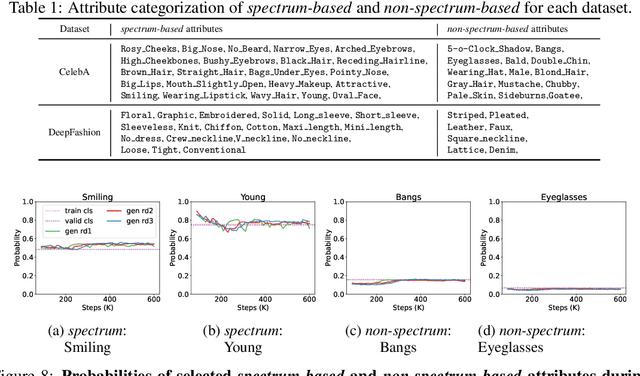
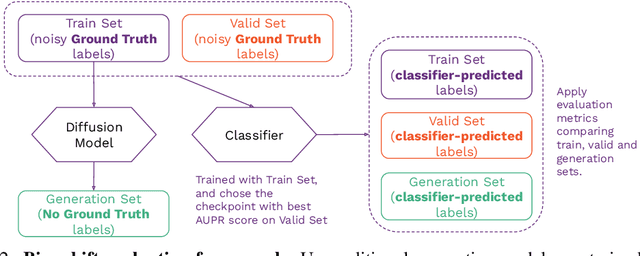
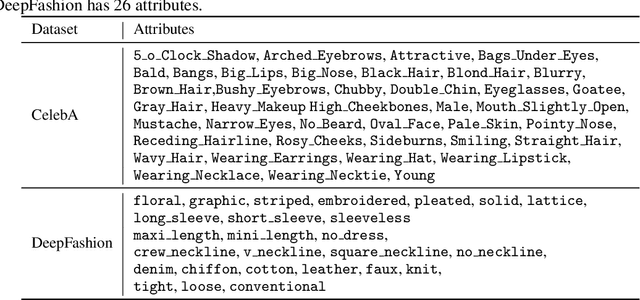
Abstract:The widespread adoption of generative AI models has raised growing concerns about representational harm and potential discriminatory outcomes. Yet, despite growing literature on this topic, the mechanisms by which bias emerges - especially in unconditional generation - remain disentangled. We define the bias of an attribute as the difference between the probability of its presence in the observed distribution and its expected proportion in an ideal reference distribution. In our analysis, we train a set of unconditional image generative models and adopt a commonly used bias evaluation framework to study bias shift between training and generated distributions. Our experiments reveal that the detected attribute shifts are small. We find that the attribute shifts are sensitive to the attribute classifier used to label generated images in the evaluation framework, particularly when its decision boundaries fall in high-density regions. Our empirical analysis indicates that this classifier sensitivity is often observed in attributes values that lie on a spectrum, as opposed to exhibiting a binary nature. This highlights the need for more representative labeling practices, understanding the shortcomings through greater scrutiny of evaluation frameworks, and recognizing the socially complex nature of attributes when evaluating bias.
CulturalFrames: Assessing Cultural Expectation Alignment in Text-to-Image Models and Evaluation Metrics
Jun 10, 2025Abstract:The increasing ubiquity of text-to-image (T2I) models as tools for visual content generation raises concerns about their ability to accurately represent diverse cultural contexts. In this work, we present the first study to systematically quantify the alignment of T2I models and evaluation metrics with respect to both explicit as well as implicit cultural expectations. To this end, we introduce CulturalFrames, a novel benchmark designed for rigorous human evaluation of cultural representation in visual generations. Spanning 10 countries and 5 socio-cultural domains, CulturalFrames comprises 983 prompts, 3637 corresponding images generated by 4 state-of-the-art T2I models, and over 10k detailed human annotations. We find that T2I models not only fail to meet the more challenging implicit expectations but also the less challenging explicit expectations. Across models and countries, cultural expectations are missed an average of 44% of the time. Among these failures, explicit expectations are missed at a surprisingly high average rate of 68%, while implicit expectation failures are also significant, averaging 49%. Furthermore, we demonstrate that existing T2I evaluation metrics correlate poorly with human judgments of cultural alignment, irrespective of their internal reasoning. Collectively, our findings expose critical gaps, providing actionable directions for developing more culturally informed T2I models and evaluation methodologies.
AdaToken-3D: Dynamic Spatial Gating for Efficient 3D Large Multimodal-Models Reasoning
May 19, 2025Abstract:Large Multimodal Models (LMMs) have become a pivotal research focus in deep learning, demonstrating remarkable capabilities in 3D scene understanding. However, current 3D LMMs employing thousands of spatial tokens for multimodal reasoning suffer from critical inefficiencies: excessive computational overhead and redundant information flows. Unlike 2D VLMs processing single images, 3D LMMs exhibit inherent architectural redundancy due to the heterogeneous mechanisms between spatial tokens and visual tokens. To address this challenge, we propose AdaToken-3D, an adaptive spatial token optimization framework that dynamically prunes redundant tokens through spatial contribution analysis. Our method automatically tailors pruning strategies to different 3D LMM architectures by quantifying token-level information flows via attention pattern mining. Extensive experiments on LLaVA-3D (a 7B parameter 3D-LMM) demonstrate that AdaToken-3D achieves 21\% faster inference speed and 63\% FLOPs reduction while maintaining original task accuracy. Beyond efficiency gains, this work systematically investigates redundancy patterns in multimodal spatial information flows through quantitative token interaction analysis. Our findings reveal that over 60\% of spatial tokens contribute minimally ($<$5\%) to the final predictions, establishing theoretical foundations for efficient 3D multimodal learning.
LensNet: An End-to-End Learning Framework for Empirical Point Spread Function Modeling and Lensless Imaging Reconstruction
May 03, 2025Abstract:Lensless imaging stands out as a promising alternative to conventional lens-based systems, particularly in scenarios demanding ultracompact form factors and cost-effective architectures. However, such systems are fundamentally governed by the Point Spread Function (PSF), which dictates how a point source contributes to the final captured signal. Traditional lensless techniques often require explicit calibrations and extensive pre-processing, relying on static or approximate PSF models. These rigid strategies can result in limited adaptability to real-world challenges, including noise, system imperfections, and dynamic scene variations, thus impeding high-fidelity reconstruction. In this paper, we propose LensNet, an end-to-end deep learning framework that integrates spatial-domain and frequency-domain representations in a unified pipeline. Central to our approach is a learnable Coded Mask Simulator (CMS) that enables dynamic, data-driven estimation of the PSF during training, effectively mitigating the shortcomings of fixed or sparsely calibrated kernels. By embedding a Wiener filtering component, LensNet refines global structure and restores fine-scale details, thus alleviating the dependency on multiple handcrafted pre-processing steps. Extensive experiments demonstrate LensNet's robust performance and superior reconstruction quality compared to state-of-the-art methods, particularly in preserving high-frequency details and attenuating noise. The proposed framework establishes a novel convergence between physics-based modeling and data-driven learning, paving the way for more accurate, flexible, and practical lensless imaging solutions for applications ranging from miniature sensors to medical diagnostics. The link of code is https://github.com/baijiesong/Lensnet.
Improving Complex Reasoning with Dynamic Prompt Corruption: A soft prompt Optimization Approach
Mar 17, 2025



Abstract:Prompt-tuning (PT) for large language models (LLMs) can facilitate the performance on various conventional NLP tasks with significantly fewer trainable parameters. However, our investigation reveals that PT provides limited improvement and may even degrade the primitive performance of LLMs on complex reasoning tasks. Such a phenomenon suggests that soft prompts can positively impact certain instances while negatively affecting others, particularly during the later phases of reasoning. To address these challenges, We first identify an information accumulation within the soft prompts. Through detailed analysis, we demonstrate that this phenomenon is often accompanied by erroneous information flow patterns in the deeper layers of the model, which ultimately lead to incorrect reasoning outcomes. we propose a novel method called \textbf{D}ynamic \textbf{P}rompt \textbf{C}orruption (DPC) to take better advantage of soft prompts in complex reasoning tasks, which dynamically adjusts the influence of soft prompts based on their impact on the reasoning process. Specifically, DPC consists of two stages: Dynamic Trigger and Dynamic Corruption. First, Dynamic Trigger measures the impact of soft prompts, identifying whether beneficial or detrimental. Then, Dynamic Corruption mitigates the negative effects of soft prompts by selectively masking key tokens that interfere with the reasoning process. We validate the proposed approach through extensive experiments on various LLMs and reasoning tasks, including GSM8K, MATH, and AQuA. Experimental results demonstrate that DPC can consistently enhance the performance of PT, achieving 4\%-8\% accuracy gains compared to vanilla prompt tuning, highlighting the effectiveness of our approach and its potential to enhance complex reasoning in LLMs.
PKRD-CoT: A Unified Chain-of-thought Prompting for Multi-Modal Large Language Models in Autonomous Driving
Dec 02, 2024
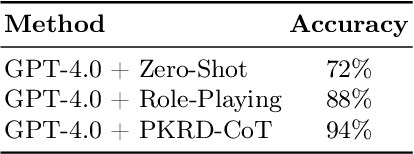
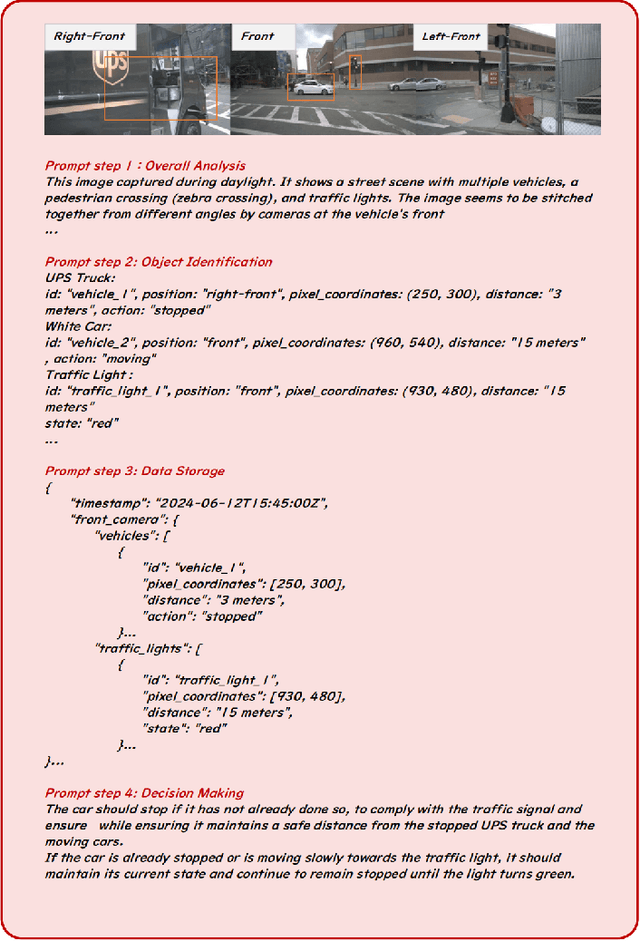

Abstract:There is growing interest in leveraging the capabilities of robust Multi-Modal Large Language Models (MLLMs) directly within autonomous driving contexts. However, the high costs and complexity of designing and training end-to-end autonomous driving models make them challenging for many enterprises and research entities. To address this, our study explores a seamless integration of MLLMs into autonomous driving systems by proposing a Zero-Shot Chain-of-Thought (Zero-Shot-CoT) prompt design named PKRD-CoT. PKRD-CoT is based on the four fundamental capabilities of autonomous driving: perception, knowledge, reasoning, and decision-making. This makes it particularly suitable for understanding and responding to dynamic driving environments by mimicking human thought processes step by step, thus enhancing decision-making in real-time scenarios. Our design enables MLLMs to tackle problems without prior experience, thereby increasing their utility within unstructured autonomous driving environments. In experiments, we demonstrate the exceptional performance of GPT-4.0 with PKRD-CoT across autonomous driving tasks, highlighting its effectiveness in autonomous driving scenarios. Additionally, our benchmark analysis reveals the promising viability of PKRD-CoT for other MLLMs, such as Claude, LLava1.6, and Qwen-VL-Plus. Overall, this study contributes a novel and unified prompt-design framework for GPT-4.0 and other MLLMs in autonomous driving, while also rigorously evaluating the efficacy of these widely recognized MLLMs in the autonomous driving domain through comprehensive comparisons.
Seeing Clearly by Layer Two: Enhancing Attention Heads to Alleviate Hallucination in LVLMs
Nov 15, 2024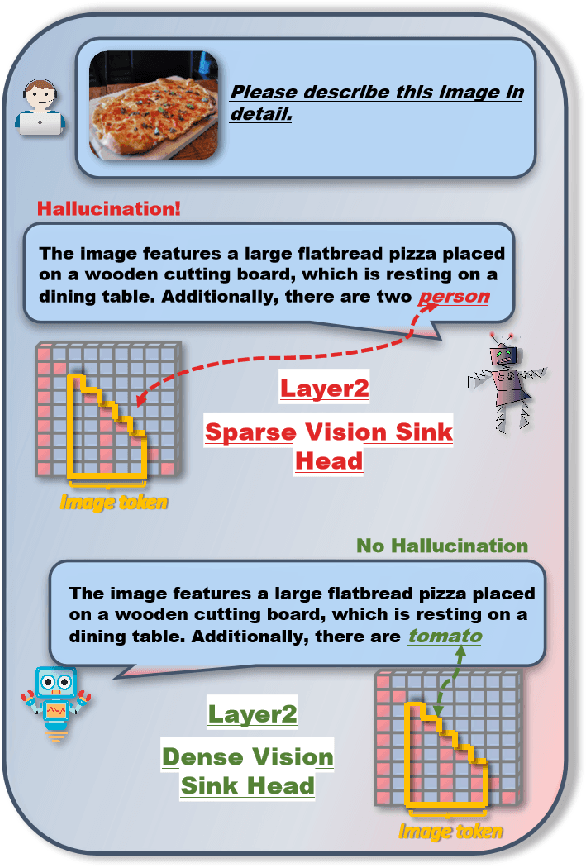
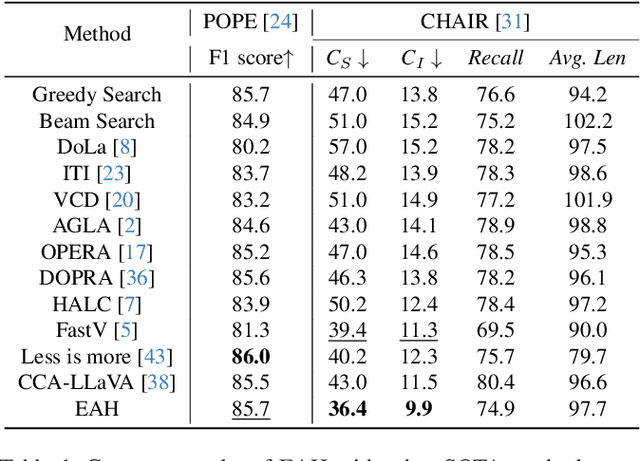
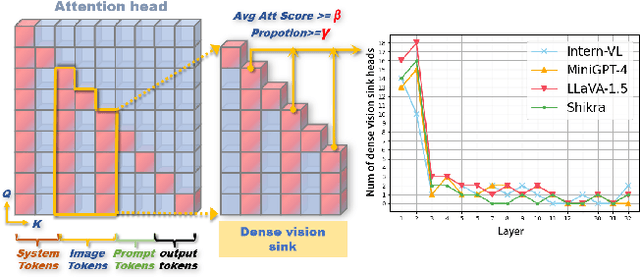
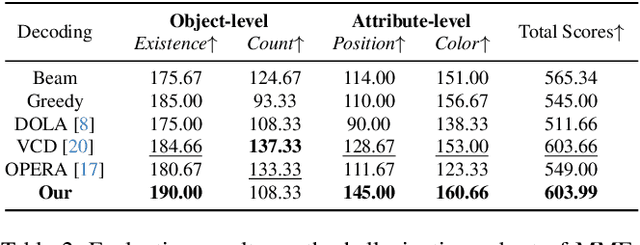
Abstract:The hallucination problem in multimodal large language models (MLLMs) remains a common issue. Although image tokens occupy a majority of the input sequence of MLLMs, there is limited research to explore the relationship between image tokens and hallucinations. In this paper, we analyze the distribution of attention scores for image tokens across each layer and head of the model, revealing an intriguing and common phenomenon: most hallucinations are closely linked to the pattern of attention sinks in the self-attention matrix of image tokens, where shallow layers exhibit dense attention sinks and deeper layers show sparse attention sinks. We further analyze the attention heads of different layers and find that heads with high-density attention sink in the image part play a positive role in alleviating hallucinations. In this paper, we propose a training-free method named \textcolor{red}{\textbf{E}}nhancing \textcolor{red}{\textbf{A}}ttention \textcolor{red}{\textbf{H}}eads (EAH), an approach designed to enhance the convergence of image tokens attention sinks in the shallow layers. EAH identifies the attention head that shows the vision sink in a shallow layer and extracts its attention matrix. This attention map is then broadcast to other heads in the layer, thereby strengthening the layer to pay more attention to the image itself. With extensive experiments, EAH shows significant hallucination-mitigating performance on different MLLMs and metrics, proving its effectiveness and generality.
DDFAV: Remote Sensing Large Vision Language Models Dataset and Evaluation Benchmark
Nov 05, 2024Abstract:With the rapid development of large vision language models (LVLMs), these models have shown excellent results in various multimodal tasks. Since LVLMs are prone to hallucinations and there are currently few datasets and evaluation methods specifically designed for remote sensing, their performance is typically poor when applied to remote sensing tasks. To address these issues, this paper introduces a high quality remote sensing LVLMs dataset, DDFAV, created using data augmentation and data mixing strategies. Next, a training instruction set is produced based on some high-quality remote sensing images selected from the proposed dataset. Finally, we develop a remote sensing LVLMs hallucination evaluation method RSPOPE based on the proposed dataset and evaluate the zero-shot capabilities of different LVLMs. Our proposed dataset, instruction set, and evaluation method files are available at https://github.com/HaodongLi2024/rspope.
High-Fidelity Document Stain Removal via A Large-Scale Real-World Dataset and A Memory-Augmented Transformer
Oct 30, 2024Abstract:Document images are often degraded by various stains, significantly impacting their readability and hindering downstream applications such as document digitization and analysis. The absence of a comprehensive stained document dataset has limited the effectiveness of existing document enhancement methods in removing stains while preserving fine-grained details. To address this challenge, we construct StainDoc, the first large-scale, high-resolution ($2145\times2245$) dataset specifically designed for document stain removal. StainDoc comprises over 5,000 pairs of stained and clean document images across multiple scenes. This dataset encompasses a diverse range of stain types, severities, and document backgrounds, facilitating robust training and evaluation of document stain removal algorithms. Furthermore, we propose StainRestorer, a Transformer-based document stain removal approach. StainRestorer employs a memory-augmented Transformer architecture that captures hierarchical stain representations at part, instance, and semantic levels via the DocMemory module. The Stain Removal Transformer (SRTransformer) leverages these feature representations through a dual attention mechanism: an enhanced spatial attention with an expanded receptive field, and a channel attention captures channel-wise feature importance. This combination enables precise stain removal while preserving document content integrity. Extensive experiments demonstrate StainRestorer's superior performance over state-of-the-art methods on the StainDoc dataset and its variants StainDoc\_Mark and StainDoc\_Seal, establishing a new benchmark for document stain removal. Our work highlights the potential of memory-augmented Transformers for this task and contributes a valuable dataset to advance future research.
 Add to Chrome
Add to Chrome Add to Firefox
Add to Firefox Add to Edge
Add to Edge